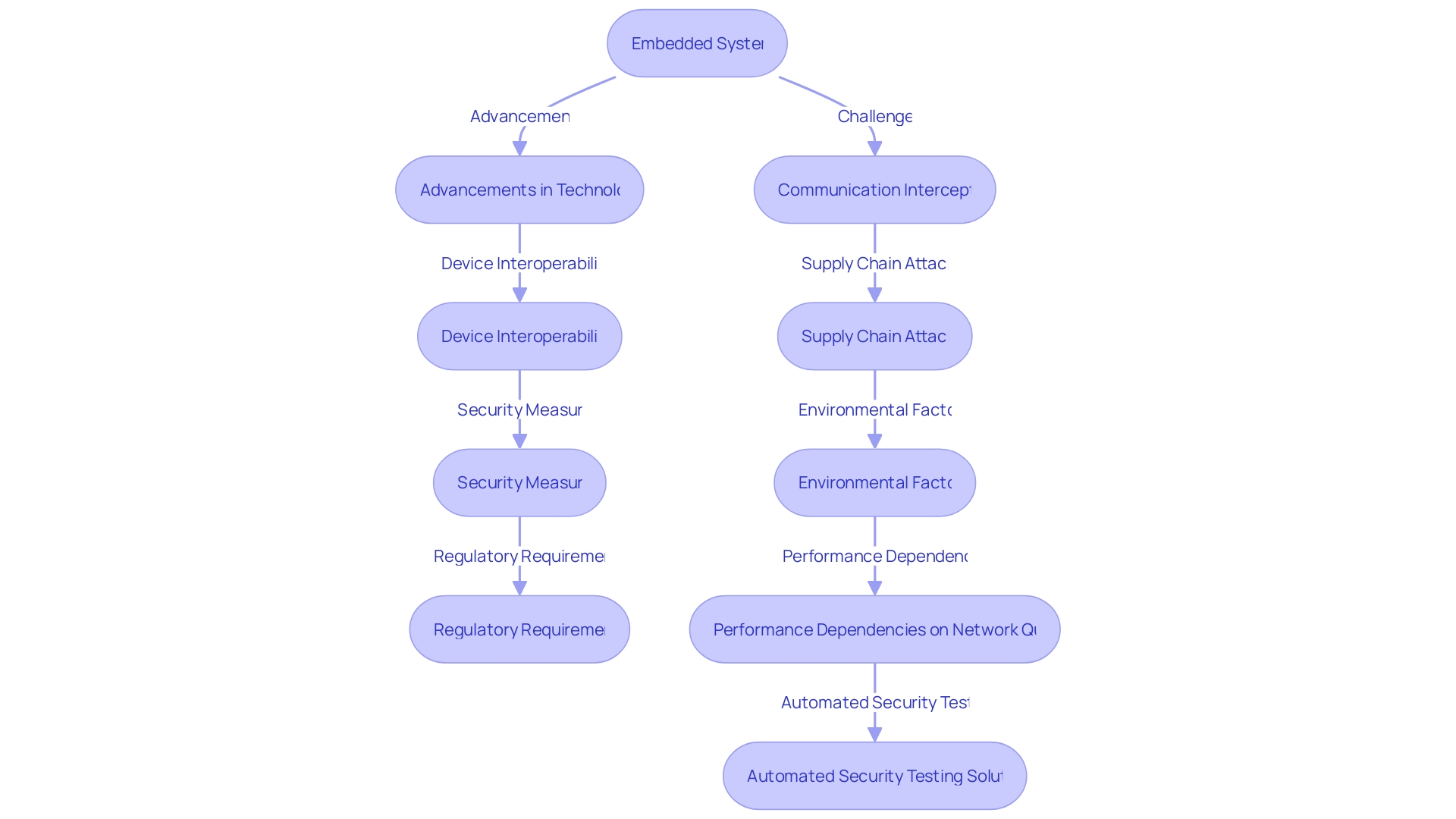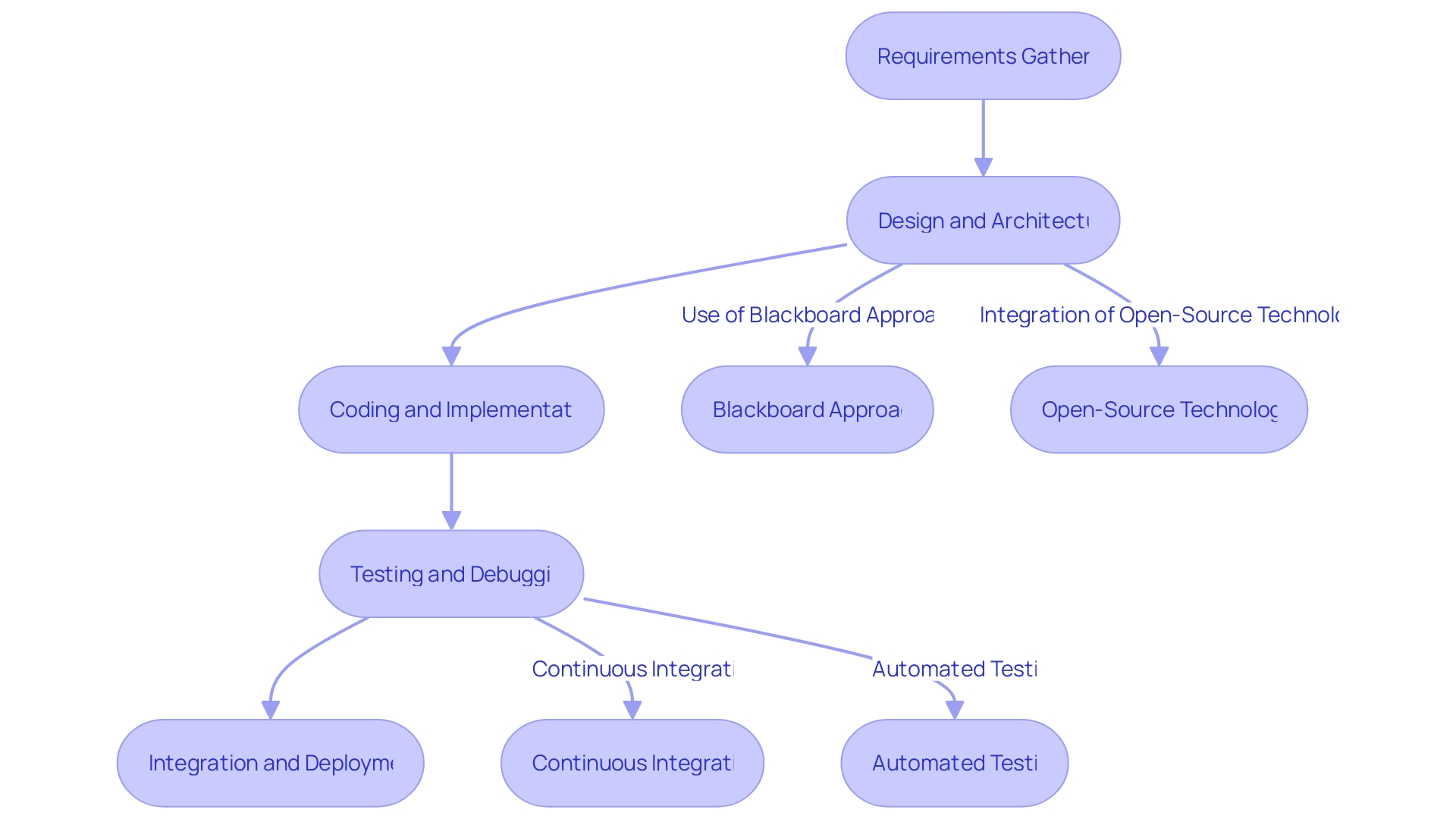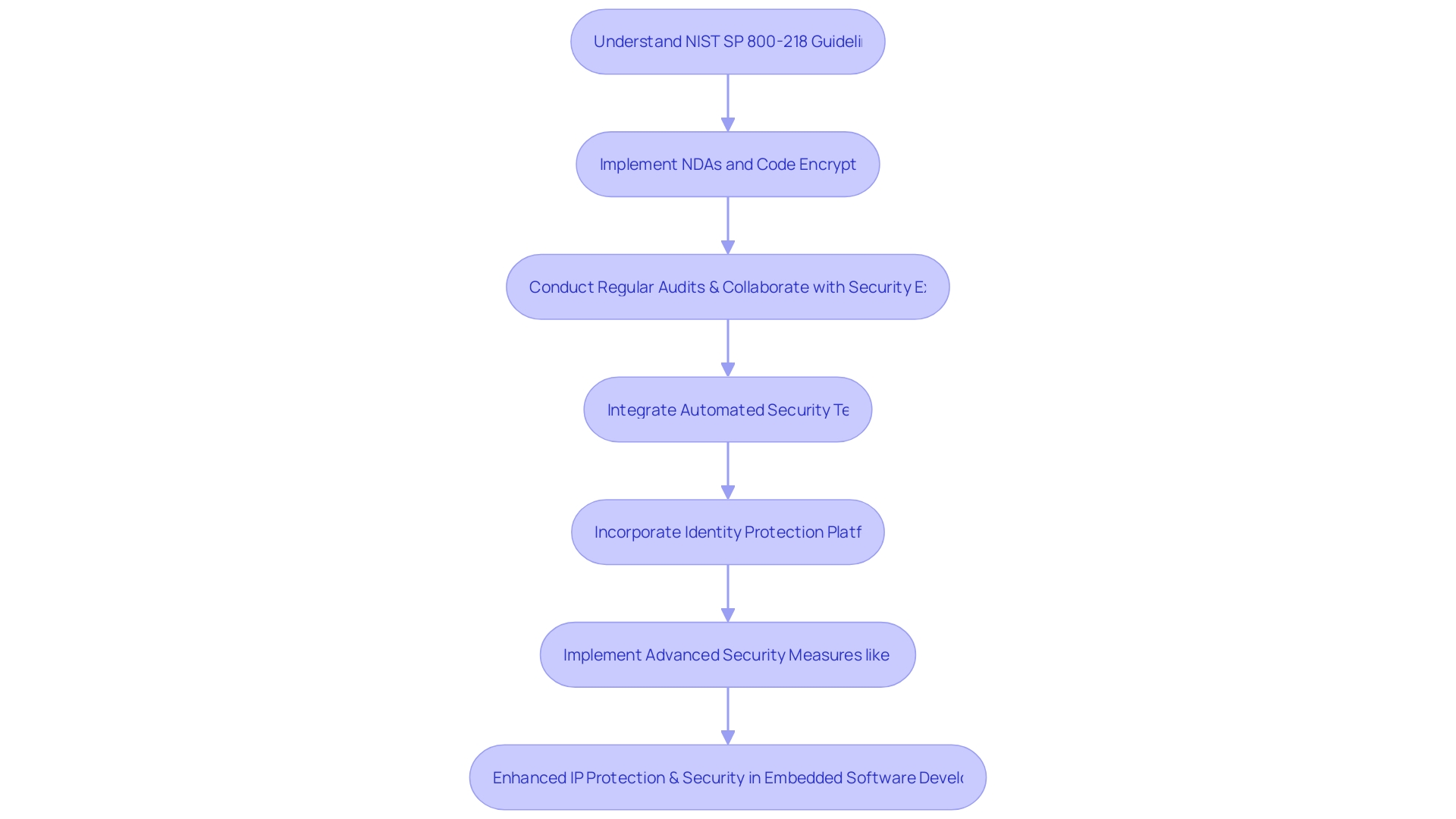Introduction
Embedded software is the lifeblood of modern devices, enabling them to perform their basic functions and be part of an interconnected ecosystem. However, the terrain of embedded software is not without its perils, with communication interception and supply chain attacks posing significant threats.
This article explores the importance of embedded software, key steps in its development, types of services offered, real-world examples, and the benefits of partnering with an embedded software development company. It also delves into the crucial aspects of IP protection and security, highlighting the need for a comprehensive approach and automated security testing. Join us as we navigate the vast landscape of embedded software and uncover the strategies to safeguard these critical systems.
The Importance of Embedded Software in Modern Devices
Embedded software is the heartbeat of modern devices, from gaming systems like the Playdate, where Swift has been harnessed to create engaging experiences, to concept cars like those designed by Filament Labs that seamlessly integrate new software without disrupting production. The evolution of embedded software has enabled devices not only to perform their basic functions but also to be part of an interconnected ecosystem that incorporates advanced technologies such as AI and ML.
The recent Matter 1.2 release underscores the ongoing advancements in embedded systems, enhancing device interoperability and security across various types, including refrigerators and air conditioners. As we witness WI-Fi solutions like Eero addressing complex networking challenges in apartments, it's clear that embedded software is pivotal in managing the intricate dance of device connectivity and performance.
However, the terrain of embedded software is not without its perils. Communication interception and supply chain attacks pose significant threats, while environmental factors can compromise the integrity of these critical systems.
Ensuring robust security measures, such as encryption and access control, is not just recommended but essential. Moreover, the integration of cloud infrastructure in embedded systems has raised concerns about performance dependencies on network quality. Adherence to regulatory requirements is another layer of complexity, demanding not only compliance with legislation but also the implementation of detailed logging for incident investigation. The push for standardization is a testament to the industry's commitment to security, efficiency, and consumer trust. As we navigate the vast landscape of embedded software, it's crucial to balance innovation with the vigilance needed to safeguard these systems against a myriad of vulnerabilities, while also embracing automated security testing solutions to manage the ever-growing number of open source components in use today.

Key Steps in Embedded Software Development
Embarking on the journey of embedded software development is a meticulous process that demands a blend of precision, foresight, and adaptability. It begins with meticulous requirements gathering, a stage that sets the foundation for the entire project.
Here, a deep understanding of the end-user's needs is paramount, as is the foresight to anticipate the evolving landscape of devices that are expected to operate relentlessly, often in a 24/7 capacity, as seen in many IoT applications. Next, we delve into the design and architecture phase, a critical juncture where the blueprint of the system is crafted.
This step often employs innovative methods such as the blackboard approach, ensuring controlled data exchange and encapsulation, which is essential in maintaining system integrity. Coding and implementation take the theoretical designs and turn them into tangible software, leveraging the power of open-source technologies.
The wide array of readily available features, from TCP/IP stacks to drivers, accelerates development while being mindful of the trade-offs associated with their cost-free nature. As we approach testing and debugging, the continuous integration mindset becomes invaluable.
This approach, characterized by frequent merging of changes, acts as a safeguard against integration issues that can arise in isolated development environments. The extensive use of automated testing, both for software and hardware components, can't be overstated, as it leads to enhanced product quality and expedited delivery. Finally, the integration and deployment phase is where continuous delivery shines, underscoring the importance of robust deployment and rollback strategies. With the ability to deploy or revert at a moment's notice, the stability of embedded systems is significantly fortified, a necessity underscored by the critical role they play in our daily lives. All these stages are underpinned by Git, a stalwart in source code management, offering scalability and control that is indispensable in modern software engineering.

Types of Embedded Software Development Services
Custom software development extends beyond the realm of typical embedded services like firmware and device driver creation. It's an intricate process that tailors solutions to the unique needs of various sectors, including supply chain management, healthcare, and education. Such development ensures that software not only fits the specific functions required but also integrates seamlessly with existing systems, enhancing efficiency and reducing errors.
In the world of custom software, flexibility is paramount. Development kits are a prime example, allowing for rapid prototyping and serving as the brain of new systems. These kits, by pre-empting the hardware design phase, accelerate the development process significantly.
The decision between custom and off-the-shelf software hinges on several factors, such as cost, implementation speed, and maintenance. While off-the-shelf options may have lower initial costs and faster deployment times, custom software offers a higher ROI over time due to its tailored nature and operational efficiencies. It provides robust security, an optimized user experience, and can evolve with the organization's changing needs.
The European IT services market, with its $389.3 billion revenue in 2022, demonstrates the burgeoning demand for such bespoke solutions. Despite economic challenges, the market's growth, fueled by digital transformation, shows no signs of slowing down. Custom software development, especially when considering web development's surge paralleling the global internet bandwidth's 28% increase in 2022, is clearly at the forefront of this expansion.

Real-World Examples of Embedded Software Development
The landscape of embedded software is reshaping industries far and wide, from automotive to healthcare, consumer electronics, and industrial automation. In the automotive sector, the integration of software-defined vehicles (SDVs) is a testament to the complexities and ongoing evolution of embedded software.
Unlike static technologies, SDVs represent a paradigm without a finish line, continuously adapting and integrating new features and security measures. The rise of Industry 4.0 and the Industrial Internet of Things (IIoT) is also indicative of this trend, as businesses leverage custom software to streamline operations and enhance efficiency.
North America is leading the charge in the embedded system market, with a strong emphasis on automotive electronics and defense, while Europe maintains a steady pace, focusing on automotive innovation and IoT applications. Companies like Intel and Marvell are at the forefront, providing critical semiconductor solutions that power these advancements. Amidst this, the importance of cybersecurity becomes ever more apparent, with industry leaders calling for more secure software development practices to safeguard against growing threats. The narrative is clear: the future is software-defined, and embedded systems are at the heart of this transformation.
Benefits of Partnering with an Embedded Software Development Company
Partnering with a specialized embedded software development firm brings a wealth of benefits, from tapping into a deep well of expertise to enjoying significant cost and time savings. These companies are adept at translating complex technical data into user-friendly formats, a vital skill for sectors like finance and banking where staff training must adhere to stringent international regulations.
For example, Stepico's innovative approach to project development, which includes interactive, story-driven games, showcases their unique blend of technology and creativity. Their ability to integrate virtual reality and augmented reality into their solutions demonstrates their commitment to leveraging the latest technologies.
Apriorit's 60% contribution rate to client product advancements underscores the substantial impact that these partnerships can have on operational capabilities. Their creation of an HR management SaaS platform, which reduced recruiting times by 30% and administrative costs by 20%, exemplifies the tangible efficiencies gained through such collaborations. With their emphasis on R&D and a team of over 400 experts, Apriorit's collaborations with clients result in groundbreaking, tailored solutions that not only meet but exceed client expectations. These partnerships ensure high-quality outcomes, fast delivery, and effective communication, making them an ideal choice for companies seeking to innovate and excel in their respective industries.
Ensuring IP Protection and Security in Embedded Software Development
In the realm of embedded software development, safeguarding intellectual property (IP) and ensuring robust security are paramount. With cybercriminals relentlessly seeking to exploit any vulnerability, the adoption of a Secure Software Development Framework (SSDF) as outlined in the Presidential Executive Order 14028 is critical. This framework mandates a comprehensive approach to embed security throughout the software development lifecycle, as per the guidelines of the National Institute of Standards and Technology (NIST) in Special Publication (SP) 800-218.
To enhance IP protection and security, measures such as Non-Disclosure Agreements (NDAs), meticulous code encryption, and secure development practices must be rigorously implemented. Regular audits and collaborations with seasoned security experts are indispensable for maintaining the integrity of embedded systems. The objective is to uphold the CIA triad—confidentiality, integrity, and availability—of sensitive data, such as proprietary application code and surveillance details.
Additionally, the integration of automated security testing within the development process is non-negotiable. As revealed by Black Duck Audit Services, an overwhelming 96% of codebases contain open source components, with an average of 526 components per application. This underscores the necessity for automated solutions like software composition analysis (SCA) to manage security compliance and licensing effectively.
The recent advancements in identity protection platforms, like the one provided by Silverfort, illustrate the power of real-time protection and the integration of a unified identity protection platform. With 83% of organizations reporting data breaches due to compromised credentials, the significance of a proactive security stance in software development cannot be overstated. By embedding security measures such as advanced Multi-Factor Authentication (MFA) and service account protection, developers can elevate the security standards and maintain customer trust in an increasingly agile and automated world.

Conclusion
In conclusion, embedded software is crucial for modern devices, enabling their functions and interconnectivity. However, it faces challenges like communication interception and supply chain attacks, necessitating robust security measures. The development of embedded software involves key steps: requirements gathering, design and architecture, coding and implementation, testing and debugging, and integration and deployment.
Each stage requires precision to ensure software integrity. Custom software development offers tailored solutions for sectors like healthcare and supply chain management, providing flexibility, security, and scalability. The European IT services market demonstrates a growing demand for bespoke solutions.
Real-world examples show how embedded software is reshaping industries such as automotive and industrial automation. Cybersecurity is increasingly important in this context. Partnering with an embedded software development company brings benefits like expertise access, cost savings, and time efficiency.
These companies excel in translating technical data into user-friendly formats and leveraging innovative technologies. IP protection and security are vital in embedded software development. Adhering to a Secure Software Development Framework (SSDF) is crucial for embedding security throughout the development lifecycle.
Measures like NDAs, code encryption, secure practices, audits, and automated security testing are necessary for system integrity. In conclusion, safeguarding embedded systems requires a comprehensive approach addressing IP protection and security concerns. By embracing best practices in development processes and partnering with specialized companies prioritizing innovation, organizations can confidently navigate the landscape of embedded software while ensuring reliable performance and protection against evolving threats.





